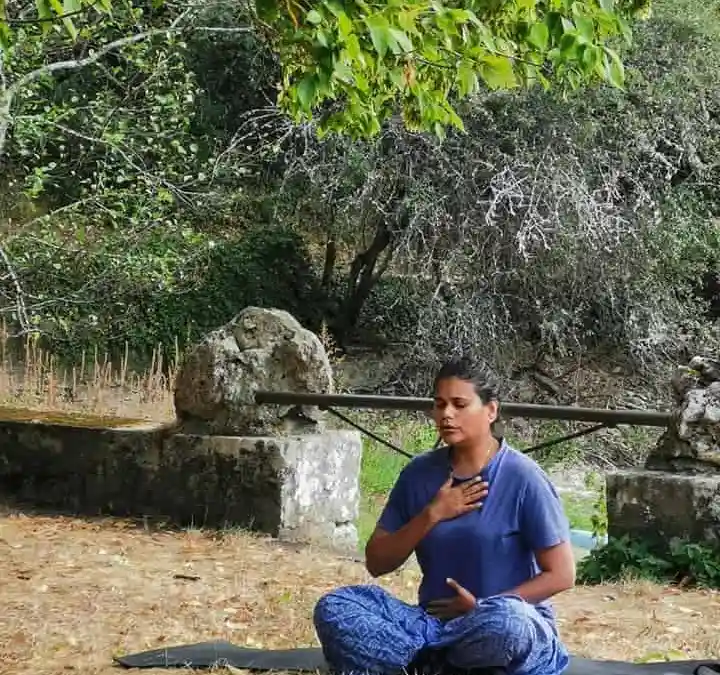“By whom the breathing has been controlled, by him the activities of the mind also have been controlled; and conversely by whom the activities of the mind have been controlled, by him the breathing also has been controlled.”
– From ‘Hatha Yoga Pradipika’ by Yogi Svatmarama
There are many different approaches to Yoga. What everyone can agree to is that it is path towards becoming a peaceful and balanced individual, with a form of enlightenment as ultimate goal.
Most people understand the importance of Asana’s and the purpose of meditation to become a Yogi, but why plays Pranayama – a practice of breath – such a great role in all Yoga traditions?
The answer lies in Maharshi Patanjali’s definition of Yoga – Yogash chitta vritti nirodhah – which can be translated as ‘Yoga stops the fluctuations of the mind’. Our mind is like a monkey which without control, jumps from one thought to the other. Uncontrolled, the mind is the cause of all the negative emotions that bring pain in our lives. If we are able to control the mind, to silence the noise that comes from within us, we are free to live up to our fullest potential. Asana by it self can not accomplish that and meditation can not be reached without this peace of mind. A step in between is required and for that reason, in Patanjali’s Ashtanga Yoga after Asana, first comes Pranayama before you can continue.
When children get upset, parents teach them to count to ten. What could possibly change in the mind of a child in these ten counts? At The Yoga Institute Hansaji Yogendra teaches her students that when an adult gets angry you should offer a glass of water. The water itself has no use, but the deep breath in afterwards reduces the tension in the body and in the mind to calm the person down. How can one breath be so powerful? Breathing exercises will teach us.
Pranayama means ’to control the vital life force’. The breath is our tool to control the Prana within us. With exercise we become aware of how we breath. Yogi’s who practice more advanced Pranayama’s gain control over the unconscious bodily functions, for example the breath, temperature control and physical desires. With the right practice it is said you can detoxify your body and conquer disease.
With improper practice of pranayama’s complications can arise. Therefore you should always follow the instructions of your teacher and not experiment by yourself. There are a few breathing exercises which are very beneficial, that are safe to practice alone. You can get more awareness and better control of your breath, accompanied by a better control of the mind and the body.
Equal breathing
Stand or sit with a straight back. Relax all your muscles, including your shoulders and your face. Inhale slowly in a count which is comfortable for you and continue in to exhaling in the same count. Feel your breath go through your lungs and in and out your belly. Practice this daily to equalize your breath and become aware of your breath multiple moments of the day.
Diaphragm breathing
Lie on your back and pull up your knees with your feet flat on the floor and your heels against your butt. Place your hand flat on your navel, keep the other hand next to your body. Inhale slowly moving your abdomen upward, without boating your stomach. Continue with equal breathing as explained above. Relax and feel your abdomen rising and sinking. Practice this daily. During the day be aware of your breath going in and out your abdomen and feel the impact it has on your mental state and stress levels.
Yogendra Pranayama 5 – Shunyaka
(Suspension of Breath, Post-exhalation)
This technique as described by The Yoga Institute helps you to find and maintain a quiet state of mind. This void, even for a while, from the ever challenging and demanding world is very important. It is not to be done by people with hypertension, cardiac problems, pregnancy, peptic and duodenal ulcers and other abdominal disorders or surgery, lower back disorders and slipped disc.
Sit in meditative posture, place your hands flat on your knees. Close your eyes or focus at one point in front of you. Inhale normally and continue in to exhaling slowly and fully until all the air is out. Pull your abdomen inwards and hold this position for five seconds without moving. Keep your airways and your mind empty. Now first relax your abdomen and then breath in. Breath normally for a while before you continue. Do this practice 4 or 5 times.
Benefits
- It strengthens a weak stomach and activates sluggish digestion and colon.
- It corrects the inflated lungs.
- It preserves elasticity of and tones the abdomen.
- It reduces distracting thoughts, calms the mind and improves focus.
Keep up your practices, gain more awareness of your breath and feel the difference it has on your mind. Remember, this is only the beginning! Want to learn more about breathing exercises and pranayama? Follow any of our courses!

